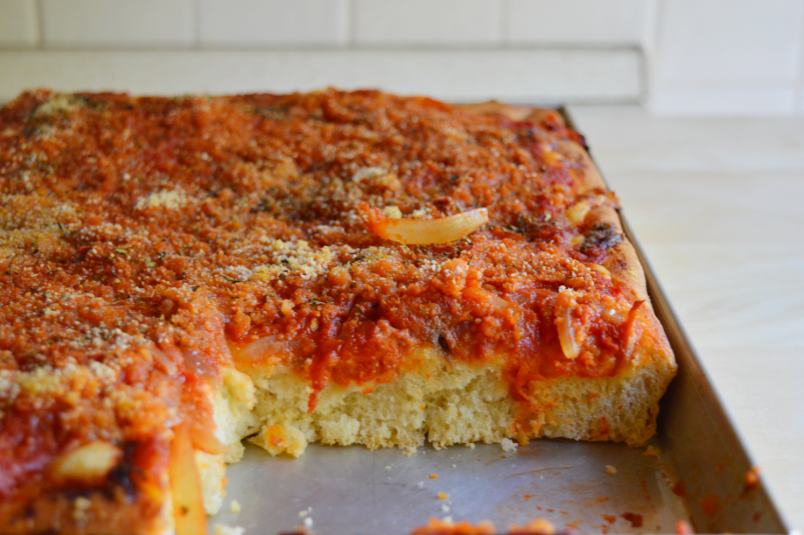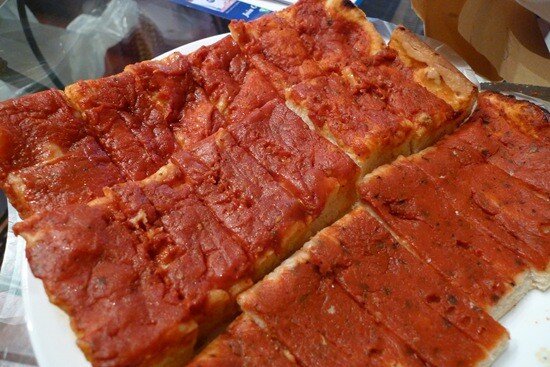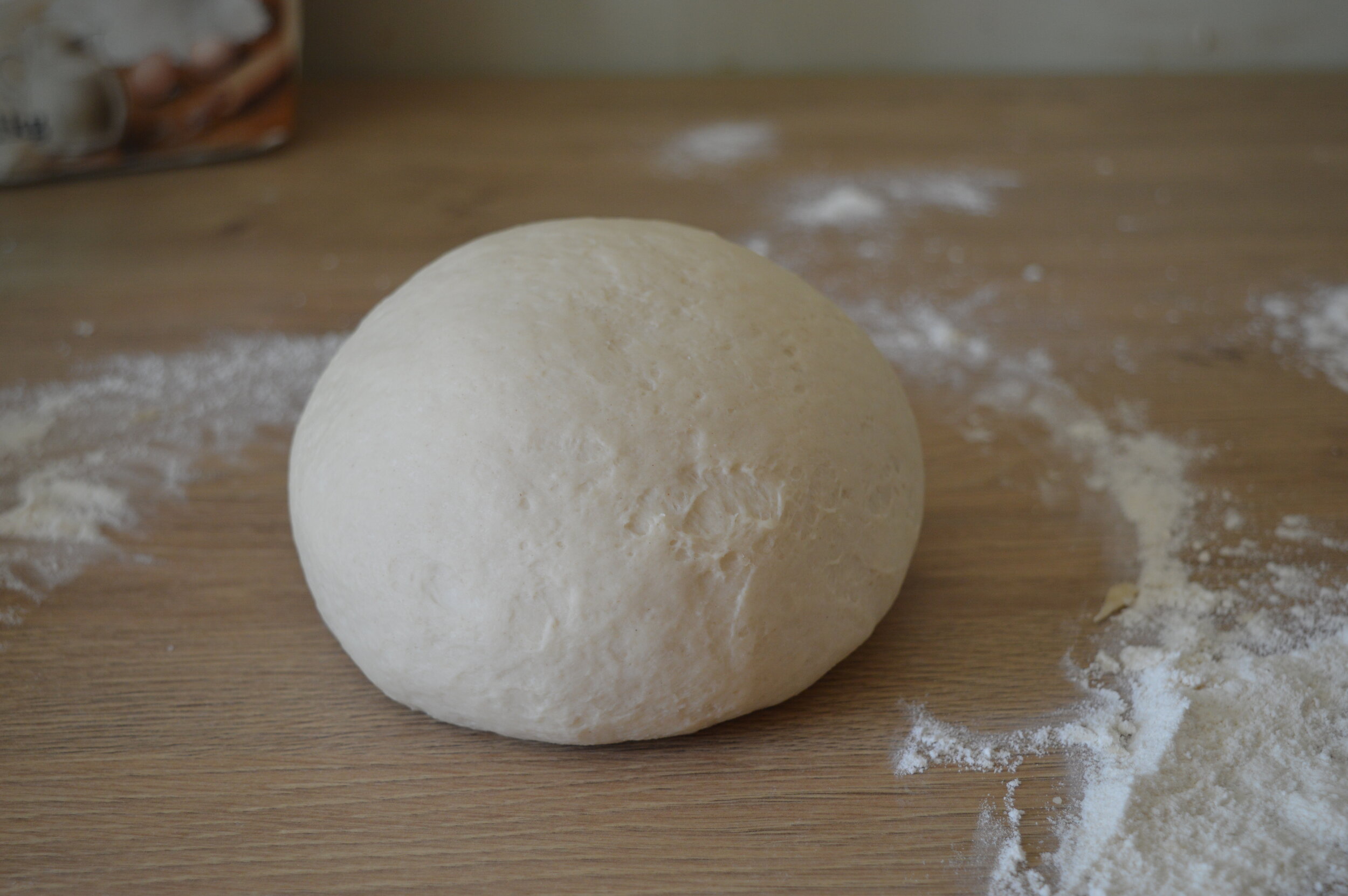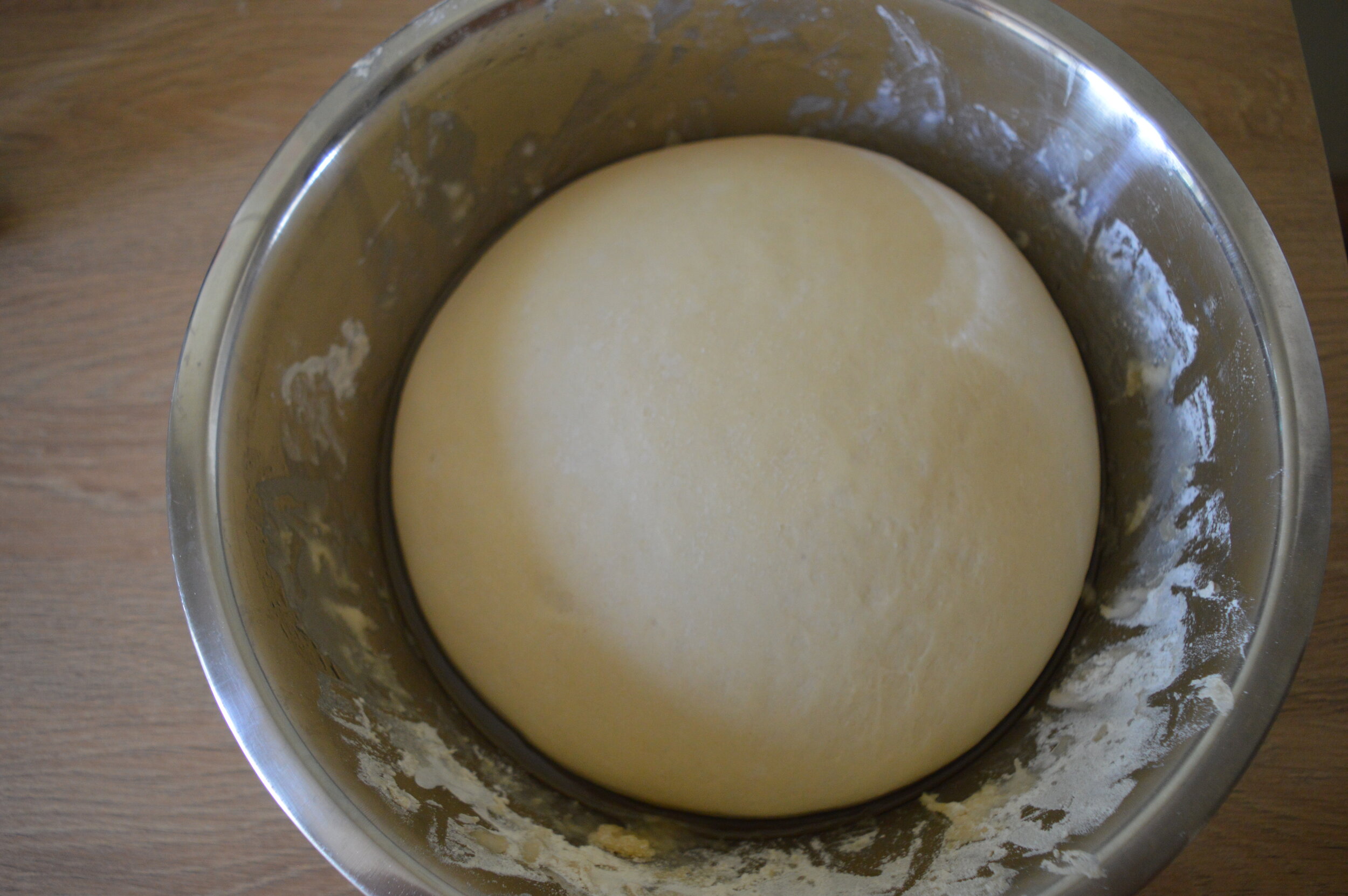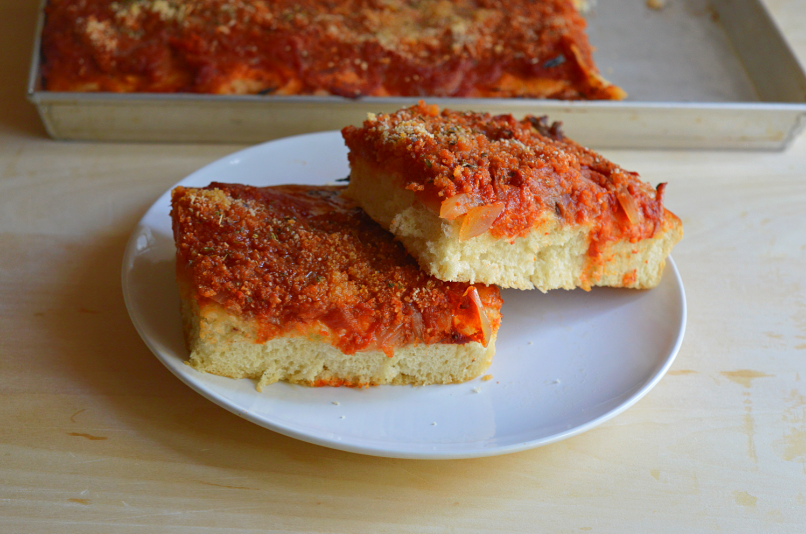Sfincione palermitano
Last week I gave you a brief overview of the gastronomic paradise that is Sicily, touching on everything from the Sicilian penchant for dessert-parading-as-breakfast to the island’s long tradition of street food, not to mention their vibrant repertoire of dolci, including the glorious cannolo. In case that post made you hungry (and I hope it did), I have a Sicilian recipe to share today, one of I suspect many I’ll be writing about in the next few weeks.
To delve a little deeper into Sicilian cuisine, I must first — strangely — start with my home state of Rhode Island.
Growing up in the smallest state, pizza strips – also known as party pizza or bakery pizza – were a staple at cookouts, birthday parties, and anywhere else where there was a crowd that needed feeding. For any non-Rhode Islanders who would be unfamiliar with this mainstay: pizza strips consist of a tall, fluffy crust generously slathered with tomato sauce. They are topped with little to no cheese and come not from pizzerias, but rather bakeries (think Zaccagnini’s in Cranston, DePetrillo’s in Coventry, or LaSalle Bakery in Providence). They look a little something like this:
Enter sfincione (pronounced sfeen-cho-nay,) a classic Sicilian street food item that I sampled in sunny, blue-skied Palermo last month. Maybe it was the bready base or the generous amount of tomato on top, but my first taste of this delightful pizza-focaccia cross was déjà vu at first bite, a quick and sudden trip from Sicily’s capital city to a childhood birthday party in Rhode Island and back again. Intrigued, I did a little research and discovered that pizza strips are indeed a descendant of Sicilian sfincione, (!!!) brought from Sicily to Rhode Island by immigrants where, like a game of culinary telephone, it transformed into what we know as pizza strips. In hindsight, this is not so surprising — nearly one in five Rhode Islanders (18.9 percent) claim Italian ancestry, meaning that Rhode Island has the highest population of Italian Americans per capita in all of the United States. Pretty cool, no?
Like pizza strips, sfincione consists of a substantial crust topped with tomato sauce. However, it also boasts onions, anchovies, caciocavallo cheese, oregano, and breadcrumbs for texture, ingredients that it shed over the years as it evolved into Rhode Island’s simpler, more pared down party pizza (also lets face it: anchovies aren’t the most child-friendly ingredient at a birthday party, right)? Having said this, abundance is a key element for both: Rhode Island pizza strips are served up in generous, party-sized trays, and Sicily’s sfincione is sold in larger than life slabs. Both are eaten at room temperature, and are convenient, easily eaten on-the-go (sfincione) or while making conversation at your neighborhood cookout (pizza strips).
So! Homemade sfincione palermitano was my first attempt to bring a little Sicily to Rome after my vacation. A little investigating taught me that there are many ways to make this classic street food; I read about sfincioni made with a 00 flour, or a mix of 00 flour and semola, and some that used malt or honey to add a sweeter flavor. There were some recipes that advised that the onions be boiled first, to soften their flavor, and some that called for fresh yeast rather than dried, and still others that called for a lievitino, or a pre-ferment. After some consideration, here is my take on sfincione palermitano, one that makes it approachable and accessible for any baker, no matter what country you’re in: I’ve opted for familiar, easy to find all-purpose flour plus sugar for sweetness, pantry-friendly dry yeast, and a mix of provolone and Pecorino, in the event that you can’t get your hands on caciocavallo siciliano. The onions are cooked in a pan with a splash or two of water, meaning no extra boiling to temper their flavor, and the dough can be made with either the help of a standing mixer equipped with a dough hook or by hand. The result? A tall, proud, fluffy crust topped with a rich tomato sauce and embellished with sweet, slow cooked onions, punchy anchovies, pleasantly sharp cheese, earthy oregano, and a sprinkle of breadcrumbs for texture. A slab of this is a true joy to eat.
And just a suggestion: I’m all for tasty, nostalgic party pizza, but a pan of homemade sfincione might be worth serving at your next gathering, don't you think?
A couple of notes: The cheese used in traditional sfincione is caciocavallo siciliano — do use this if you can get your hands on it or are living in Italy. If not, I find a mix of provolone and Pecorino makes a good substitute. If anchovies aren’t your thing, feel free to omit them, but they do add a nice flavor. Most Italians have a pair of kitchen scissors to cut pizza in to slices, and I recommend you do the same; it is the easiest way to cut the sfincione into slabs.
Looking for other pizza or bread recipes? Click here.
SFINCIONE PALERMITANO
Serves 6-8.
Ingredients for the base:
4 1/4 cups (550 grams) all-purpose flour
2 teaspoons (12.5 grams) salt
4 teaspoons (25 grams) of sugar
1.5 teaspoons (6 grams) dry yeast
3 tablespoons (30 grams) vegetable oil
1 cup (250 grams) warm water
Ingredients for the topping:
2 cans (800 grams) crushed tomatoes
2 medium yellow onions
1/2 cup (120mL) water
4 ounces (100 grams) provolone cheese
3 tablespoons (20 grams) plain breadcrumbs
1/3 cup (20 grams) Pecorino cheese, freshly grated
1/3 cup (40 grams) anchovies packed in oil, drained
Olive oil
Dried oregano to taste
Salt to taste
Directions:
1.) Place the yeast in a small bowl and add about 1/3 cup of the water. Let sit for five minutes or until bubbly. In a large bowl, mix together the flour, sugar, and oil, and then add the yeast/water mixture. Stir well, and then add the salt and another 1/3 cup of the water. Continue to mix the ingredients together, adding the rest of the water as you go. Squeeze the dough together with your hands to get the water incorporated. If the dough feels dry, add a little more water a tablespoon at a time.
2.) Next, turn the dough out on to a lightly floured work surface and knead until the dough becomes soft and elastic, about 10 minutes (this can also be done with the dough hook of a standing mixer, if you have one). Form the dough into a ball and leave it to rise in a in a greased bowl, covered, for 2 hours.
3.) While the dough rises, prepare the toppings. Peel your onions and cut them into thin slices. Cook the onion in a pan over medium heat with a little olive oil until softened, and then add about 1/2 a cup of water. Turn the heat up to medium, and let the onion cook until all the water is evaporated, stirring occasionally. Season the onions with a little salt, and then add the tomatoes to the pan. Stir well, and let the mixture cook for about 25 minutes, until thickened, stirring occasionally. Taste and add more salt if needed, then set your sfincione sauce aside to cool completely.
4.) When the two hours are up, grease a 12 x 14 inch rectangular pan with some olive oil. Punch down the dough to deflate it, and then fit it into the pan, stretching it to the edges. Cover the pan with a tea towel and let rest the dough again for another 30 minutes. While you wait, cut the provolone into small cubes and set aside. Grate the Pecorino cheese, and tear the anchovies into pieces. Toast the breadcrumbs in a small pan over low heat until they are lightly browned.
5.) When the half hour is up, preheat the oven to 375 degrees Fahrenheit. Sprinkle the sfincione base with anchovies and both of the cheeses, and cover all ingredients with the tomato sauce, spreading it to the edges but leaving a slight border. Sprinkle the tomato sauce with breadcrumbs and dried oregano to taste. Bake the sfincione for 30-40 minutes, or until the sauce bubbles slightly, the cheeses are melted, and the crust is golden brown. Let cool slightly, and cut into slices.

